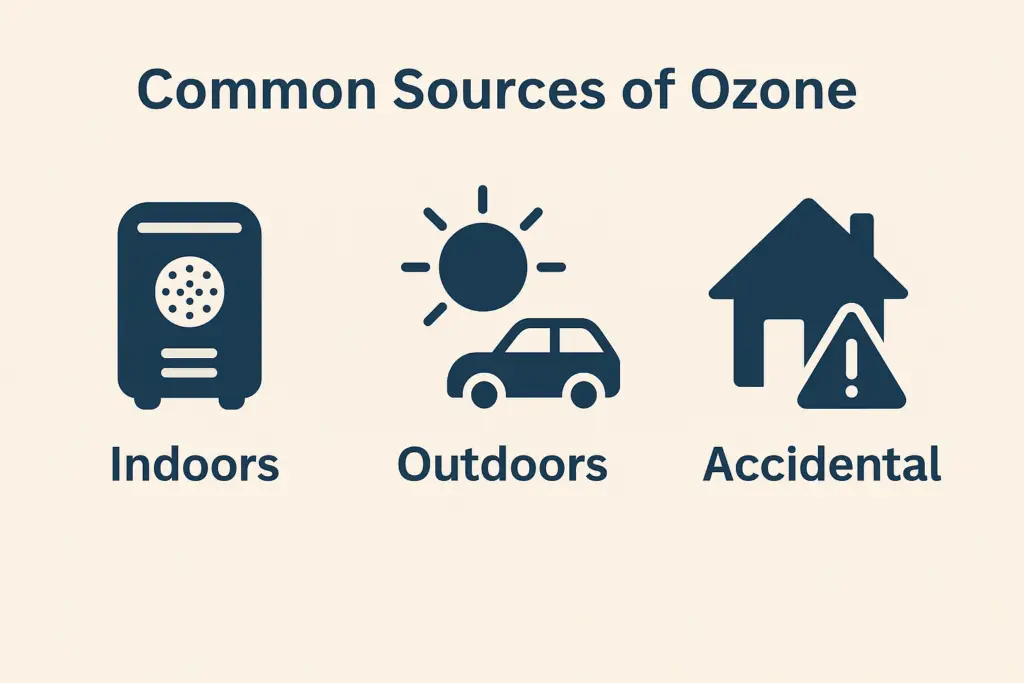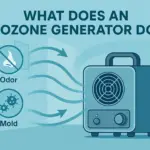If you breathe in ozone, move to fresh air immediately, rest, and monitor for irritation such as coughing, chest tightness, or watery eyes. Mild symptoms often fade, but if shortness of breath, chest pain, or wheezing persists, seek medical care right away. People with asthma, COPD, children, and pets are especially vulnerable.
Table of Contents
What Do You Do If You Breathe Ozone?
Breathing in ozone can cause irritation almost immediately. Ozone is sometimes used indoors for odor removal or mold cleanup, but it is not safe to inhale. Outdoors, it is a common part of smog on hot, sunny days. Knowing what steps to take if you’ve been exposed can help minimize harm and prevent lasting health issues.
Immediate Steps to Take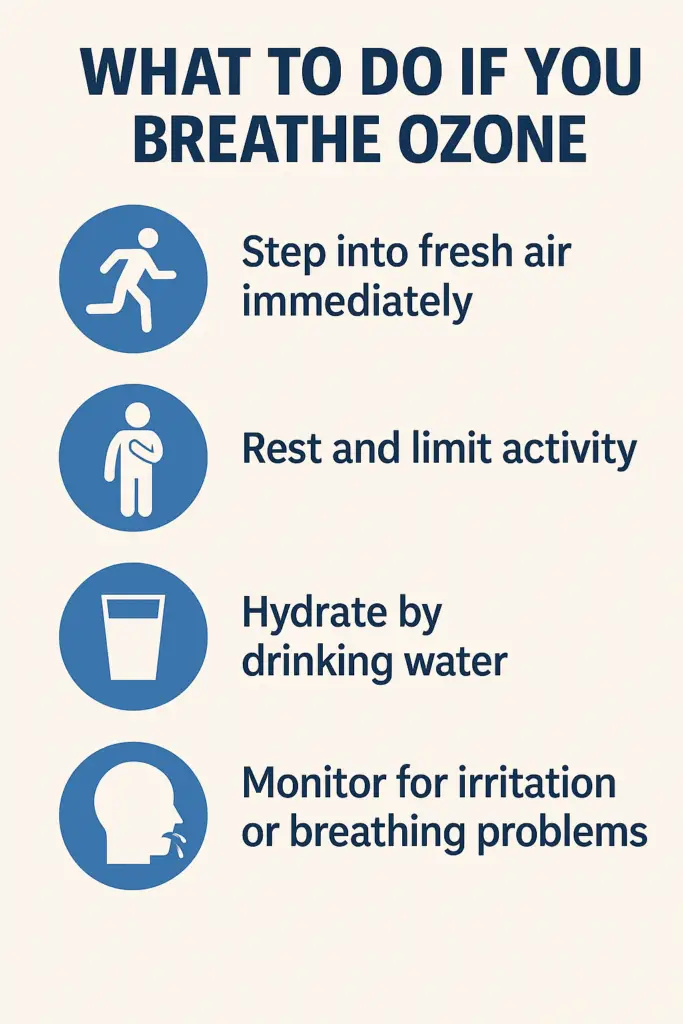
If you think you’ve breathed ozone, quick action matters:
- Get to fresh air: Leave the area where ozone is present as soon as possible.
- Rest and limit activity: Exertion makes irritation worse.
- Drink water: Staying hydrated can soothe your throat and reduce dryness.
- Monitor your breathing: Pay attention to whether coughing or chest tightness clears up or lingers.
Example: You walk into a room just after running an ozone generator for pet odors. Your throat feels scratchy and you cough. Step outside, sip water, and avoid exertion until irritation fades.
Another example: On a hot summer day, your child plays outside and comes in coughing and rubbing their eyes. Checking the local Air Quality Index (AQI) shows high ozone levels — the right move is to keep them inside with filtered air until the air clears.
Symptoms of Ozone Exposure
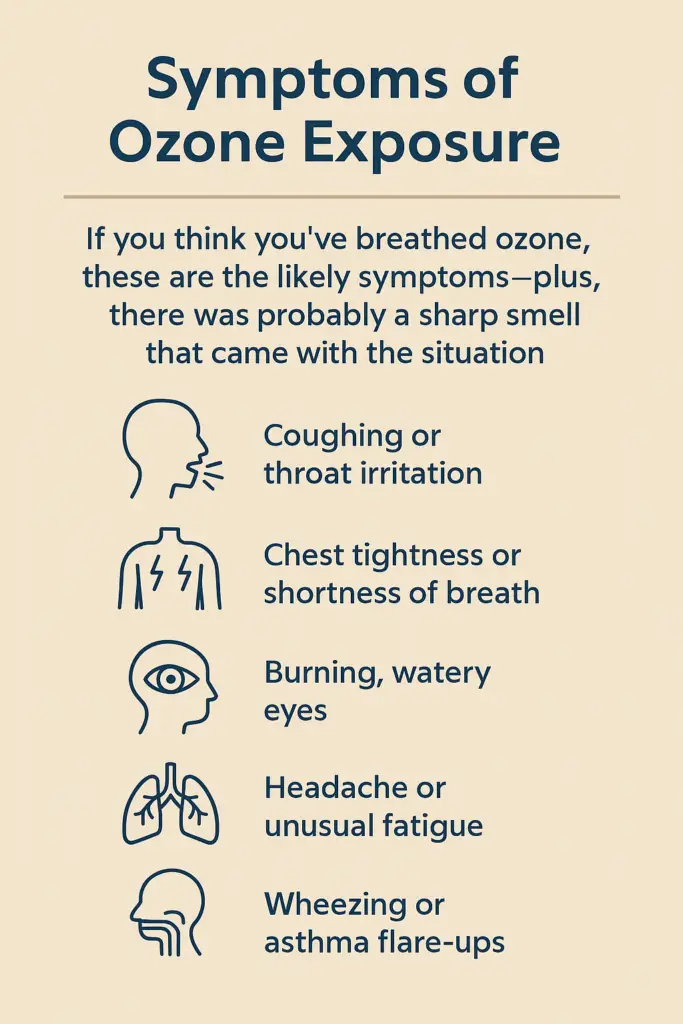
If you think you’ve breathed ozone, these are the likely symptoms you may notice — and chances are there was also a sharp, almost chlorine-like smell that came with the situation.
- Coughing or throat irritation
- Chest tightness or shortness of breath
- Burning, watery eyes
- Headache or unusual fatigue
- Wheezing or asthma flare-ups
The “fresh” or “electric” smell of ozone is not a sign of cleanliness — it’s a warning. If you can smell it, you are already breathing it.
How Long Do Symptoms Last?
Recovery depends on how much ozone you inhaled and your personal health:
- Mild exposure: Symptoms may fade within minutes to a few hours.
- Moderate exposure: Coughing or chest irritation can last a day or longer.
- Severe exposure: Recovery may require medical care and can take several days.
When Should You Be Concerned?
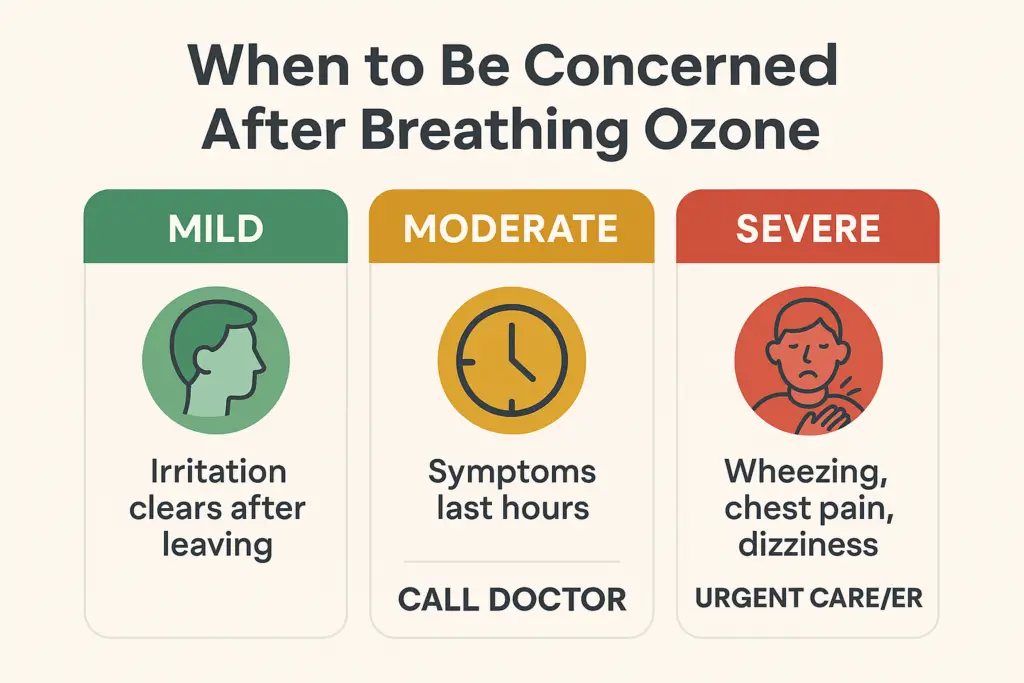
Not every exposure requires emergency care, but knowing the difference is important:
- Mild symptoms: Irritation clears after leaving the area.
- Persistent symptoms: Lingering cough, headache, or sore throat lasting hours → call your doctor.
- Severe symptoms: Wheezing, chest pain, dizziness, or worsening asthma → seek urgent care.
Pet example: A dog left inside while an ozone machine runs comes out coughing and lethargic. Pets can suffer just like people — fresh air and a call to the vet are the right steps.
Who Is Most at Risk?
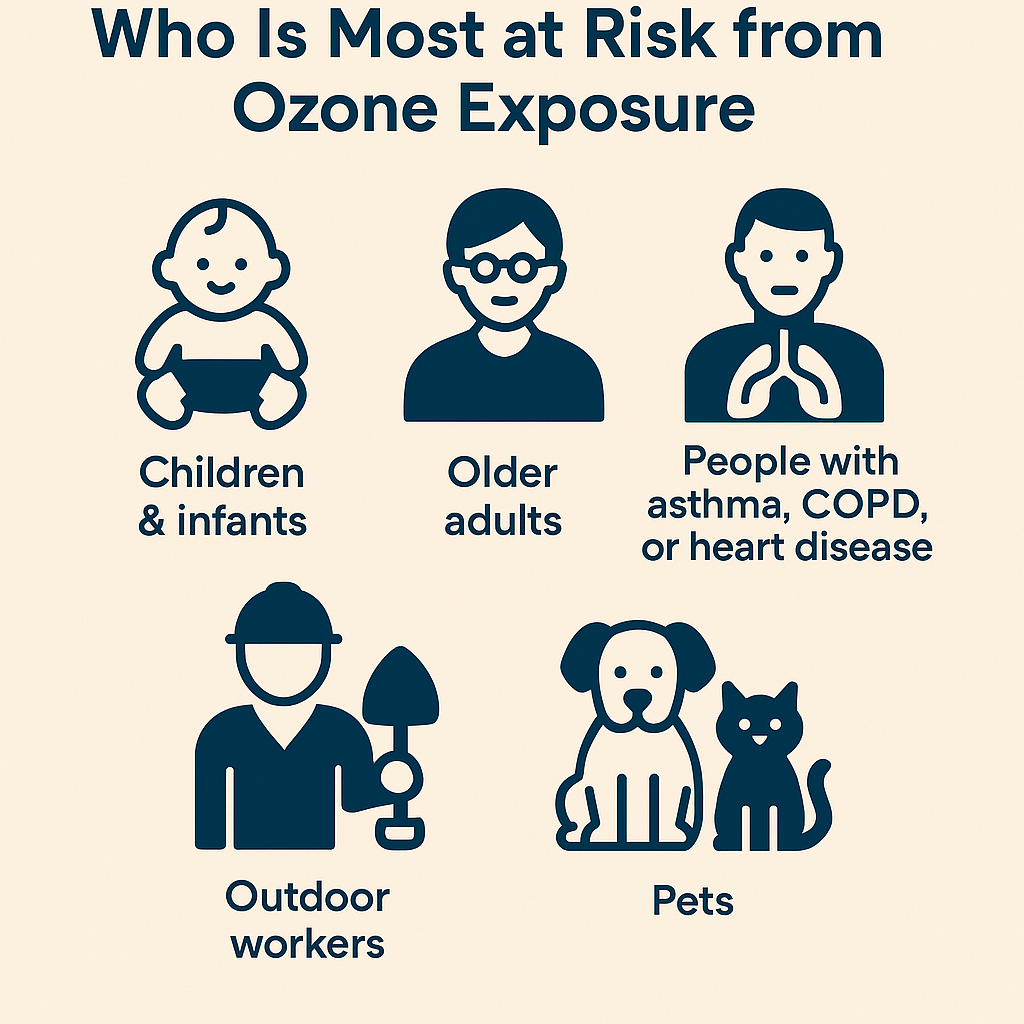
Some people are more vulnerable to ozone’s effects:
- Children and infants with developing lungs
- Older adults
- People with asthma, COPD, or heart disease
- Outdoor workers on high ozone days
- Pets, especially dogs and cats
Possible Long-Term Effects
While mild accidental exposure often clears up, repeated or heavy exposure can cause:
- Reduced lung function
- Increased asthma attacks
- Lung tissue damage over time
- Potential cardiovascular stress
Common Sources of Ozone
Indoors: Ozone generators, ionizers, some UV-based purifiers (see our guide on ionizers)
- Outdoors: Smog from traffic, heat, and sunlight
- Accidental: Using ozone for smoke or mold cleanup while people or pets are still inside (learn more about ozone generators here)
First Aid vs. Medical Care
A simple way to decide:
- Symptoms fade quickly: Rest and monitor at home.
- Symptoms linger more than a few hours: Call your doctor.
- Severe breathing issues or chest pain: Go to urgent care or the ER right away.
How to Prevent Ozone Exposure
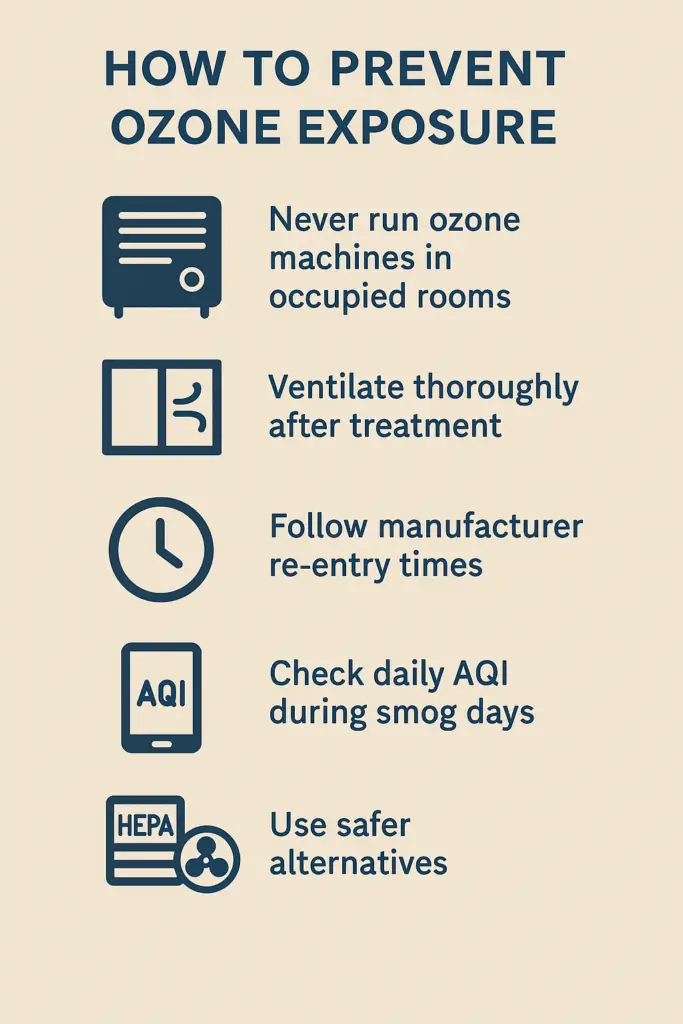
You can reduce the risk of inhaling ozone by taking simple precautions:
- Never run ozone machines in occupied rooms: Ozone generators should only be used when no people or pets are present.
- Ventilate thoroughly after use: Open windows or run fans to clear out leftover ozone before re-entering.
- Follow manufacturer re-entry times: Many machines require waiting two to four hours before the room is safe again.
- Check the Air Quality Index (AQI): Avoid outdoor activity on high-smog days. Many weather apps report daily ozone levels.
- Use safer alternatives: HEPA filters and activated carbon remove dust, smoke, and odors without producing ozone (see carbon filter safety here).Just like with ozone, bleach fumes can also cause throat and lung irritation. Learn more in our guide on what to do if you inhale bleach fumes.
FAQs About Breathing Ozone
-
- Can one breath of ozone hurt you? Usually not, but sensitive people may react strongly.
- How long does it take to recover? Mild irritation may fade in minutes to hours; heavier exposure can last days.
- Is smelling ozone dangerous? Yes — the smell means you’re already breathing it.
- What if my pet breathes ozone? Pets can show coughing or lethargy; remove them to fresh air and call a vet if symptoms continue.
- Can you detox after ozone exposure? Your body clears ozone naturally, but rest and hydration help recovery.
- How long does ozone stay in the air indoors? Depending on ventilation, ozone can linger from 30 minutes to several hours after a machine is turned off.
- Is ozone the same as oxygen? No — oxygen is O₂, while ozone is O₃. That extra molecule makes it unstable and irritating to the lungs.
- Does ozone smell mean my air purifier is working? No — ozone-producing purifiers are not safe for everyday use, and the smell is a warning sign of exposure.
Many people rent ozone generators without understanding safety. Here’s a practical guide on whether to rent or buy an ozone machine and how to use it safely
Key Takeaway
If you breathe ozone, the most important steps are to leave the area, rest, and watch your symptoms. Ozone is not safe to inhale, and prevention is always the best strategy.
Disclaimer: This article was created with the assistance of AI tools. It is intended for general informational purposes only. Ozone exposure can cause health risks, and individual reactions may vary. Always consult a qualified healthcare provider if you experience concerning symptoms or need medical advice.


